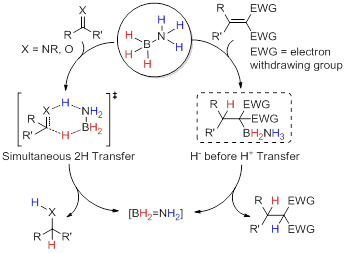| [1] (a) Berke, H. ChemPhysChem 2010, 11, 1837. (b) Ujaque, G.; Lledós, A. J. Mol. Struct.: THEOCHEM 2009, 903, 123.
[2] (a) Meerwein, H.; Schmidt, R. Justus Liebigs Ann. Chem. 1925, 444, 221. (b) Ponndorf, W. Angew. Chem. 1926, 39, 138. (c) Verley, A. Bull. Soc. Chim. Fr. 1925, 37, 871.
[3] (a) Noyori, R.; Okhuma, T.; Kitamura, M.; Takaya, H.; Sayo, N.; Kumobayashi, H.; Akuragawa, S. J. Am. Chem. Soc. 1987, 109, 5856. (b) Noyori, R. In Organic Synthesis, Wiley-Interscience, John Wiley & Sons, New York, 1994, pp. 16~94 and references cited therein. (c) Blum, Y.; Czarkie, D.; Rahamim, Y.; Shvo, Y. Organometallics 1985, 4, 1459. (d) Shvo, Y.; Czarkie, D.; Rahamim, Y.; Chodosh, D. F. J. Am. Chem. Soc. 1986, 108, 7400. (e) Casey, C. P.; Strotman, N. A.; Beetner, S. E.; Johnson, J. B.; Priebe, D. C.; Vos, T. E.; Khodavandi, B.; Guzei, I. A. Organometallics 2006, 25, 1230.
[4] (a) Miller, D. J.; Smith, D. M.; Chan, B.; Radom, M. Mol. Phys. 2006, 104, 777. (b) Fernández, I.; Sierra, M. A.; Cossío, F. P. J. Org. Chem. 2007, 72, 1488.
[5] Feller, D. F.; Schmidt, M. W.; Ruedenberg, K. J. Am. Chem. Soc. 1982, 104, 960.
[6] McKee, M. L.; Stanbury, D. M. J. Am. Chem. Soc. 1992, 114, 3214.
[7] (a) Hamilton, C. W.; Baker, R. T.; Staubitz, A.; Manners, I. Chem. Soc. Rev. 2009, 38, 279. (b) Marder, T. B. Angew. Chem., Int. Ed. 2007, 46, 8116. (c) Gutowska, A.; Li, L.; Shin, Y.; Wang, M.; Li, X. S.; Linehan, J. C.; Smith, R. S.; Kay, B. D.; Schmid, B.; Shaw, W.; Gutowski, M.; Autrey, T. Angew. Chem., Int. Ed. 2005, 44, 3578. (d) Grochala, W.; Edwards, P. P. Chem. Rev. 2004, 104, 1283.
[8] (a) Zhang, L.; Tu, Q.; Chen, X.; Liu, P. Prog. Chem. 2014, 26, 749. (b) Yang, L.; Cao, N.; Du, C.; Dai, H.; Hu, K.; Luo, W.; Cheng, G. Mater. Lett. 2014, 115, 113. (c) Li, H.; Yang, Q,; Chen, X.; Shore, S. G. J. Organomet. Chem. 2014, 751, 60. (d) Kim, Y.; Baek, H.; Lee, J. H.; Yeo, S.; Kim, K.; Hwang, S. J.; Eun, B.; Nam, S. W.; Lim, T. H.; Yoon, C. W. Phys. Chem. Chem. Phys. 2013, 15, 19584. (e) Hartmann, C. E.; Jurcik, V.; Songis, O.; Cazin, C. S. Chem. Commun. 2013, 49, 10629. (f) Marder, T. Angew. Chem., Int. Ed. 2007, 46, 8116. (k) Denney, M. C.; Pons, V.; Hebden, T. J.; Heinekey, D. M.; Goldberg, K. I. J. Am. Chem. Soc. 2006, 128, 12048.
[9] (a) Parvanov, V. M.; Schenter, G. K.; Hess, N. J.; Daemen, L. L.; Hartl, M.; Stowe, A. C.; Camaionia, D. M.; Autrey, T. Dalton Trans. 2008, 33, 4514. (b) Rasul, G. K. G.; Prakash, S.; Olah, G. A. THEOCHEM 2007, 818, 65.
[10] (a) Yurderi, M.; Bulut, A.; Zahmakiran, M.; Gulcan, M.; Ozkar, S. Appl. Catal. B, Environ. 2014, 160, 534. (b) Dong, H.; Berke, H. J. Organomet. Chem. 2011, 696, 1803. (c) Jiang, Y.; Blacque, O.; Fox, T.; Frech, C. M.; Berke, H. Organometallics 2009, 28, 5493. (d) Jiang, Y.; Berke, H. Chem. Commun. 2007, 3571.
[11] Hartmann, C. E.; Jurcik, V.; Songis, O.; Cazin, C. S. Chem. Commun. 2013, 49, 1005.
[12] Yang, X.; Zhao, L.; Fox, T.; Wang, Z.-X.; Berke, H. Angew. Chem., Int. Ed. 2010, 49, 2058.
[13] Morse, P. M. Phys. Rev. 1929, 34, 57.
[14] (a) Hammett, L. P. J. Am. Chem. Soc. 1937, 59, 96. (b) Hammett, L. P. Chem. Rev. 1935, 17, 125.
[15] (a) Yang, X.; Fox, T.; Berke, H. Chem. Commun. 2011, 47, 2053. (b) Yang, X.; Fox, T.; Berke, H. Org. Biomol. Chem. 2012, 10, 852.
[16] (a) Smythe N. C.; Gordon, J. C. Eur. J. Inorg. Chem. 2010, 509. (b) Pons, V.; Baker, R. T.; Szymczak, N. K.; Heldebrant, D. J.; Linehan, J. C.; Matus, M. H.; Grant D. J.; Dixon, D. A. Chem. Commun. 2008, 6597. (c) Shrestha, R. P.; Diyabalanage, H. V. K.; Semelsberger, T. A.; Ott K. C.; Burrell, A. K. Int. J. Hydrogen Energy 2009, 34, 2616.
[17] Yang, X.; Fox, T.; Berke, H. Tetrahedron 2011, 7121.
[18] Brown, H. C.; Schlesinger, H. I.; Burg, A. B. J. Am. Chem. Soc. 1939, 61, 673.
[19] (a) Brown, H. C.; Wang, K, K.; Chandrasekharan, J. J. Am. Chem. Soc. 1983, 105, 2343. (b) Kudo, T.; Higashide, T.; Ikedate, S.; Yamataka, H. J. Org. Chem. 2005, 70, 5157.
[20] Xu, W.; Fan, H.; Wu, G.; Chen, P. New J. Chem. 2012, 36, 1496.
[21] Xu, W.; Wu, G.; Yao, W.; Fan, H.; Wu, J.; Chen, P. Chem. Eur. J. 2012, 18, 13885.
[22] Wang, X.; Yao, W.; Zhou, D.; Fan, H. Mol. Phys. 2013, 111, 3014. |
